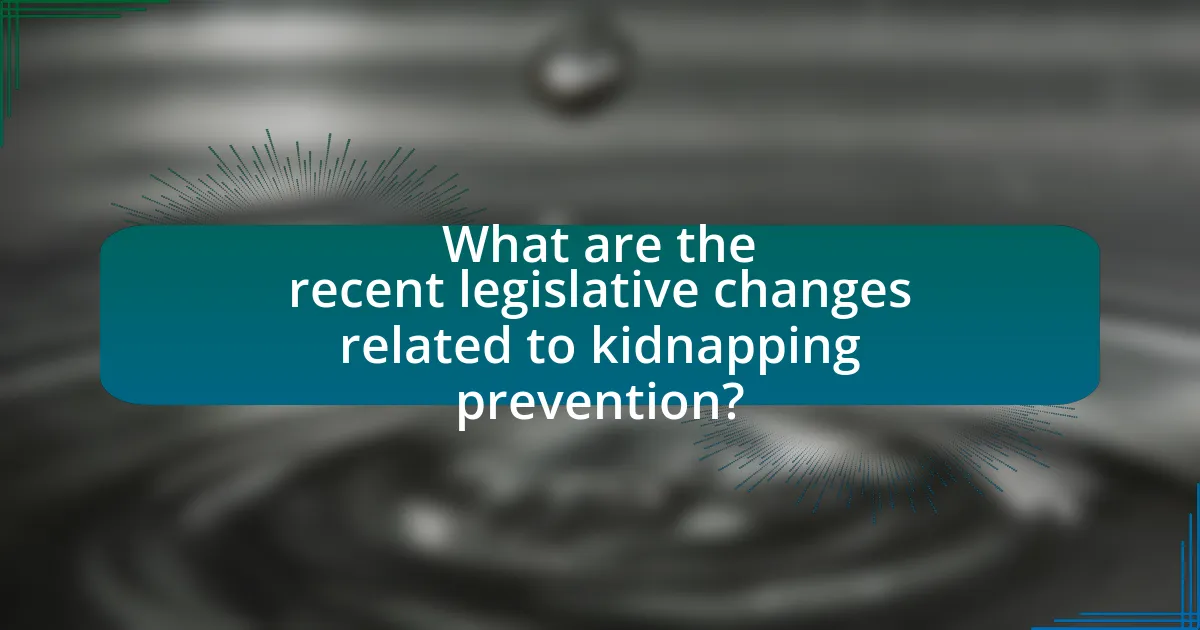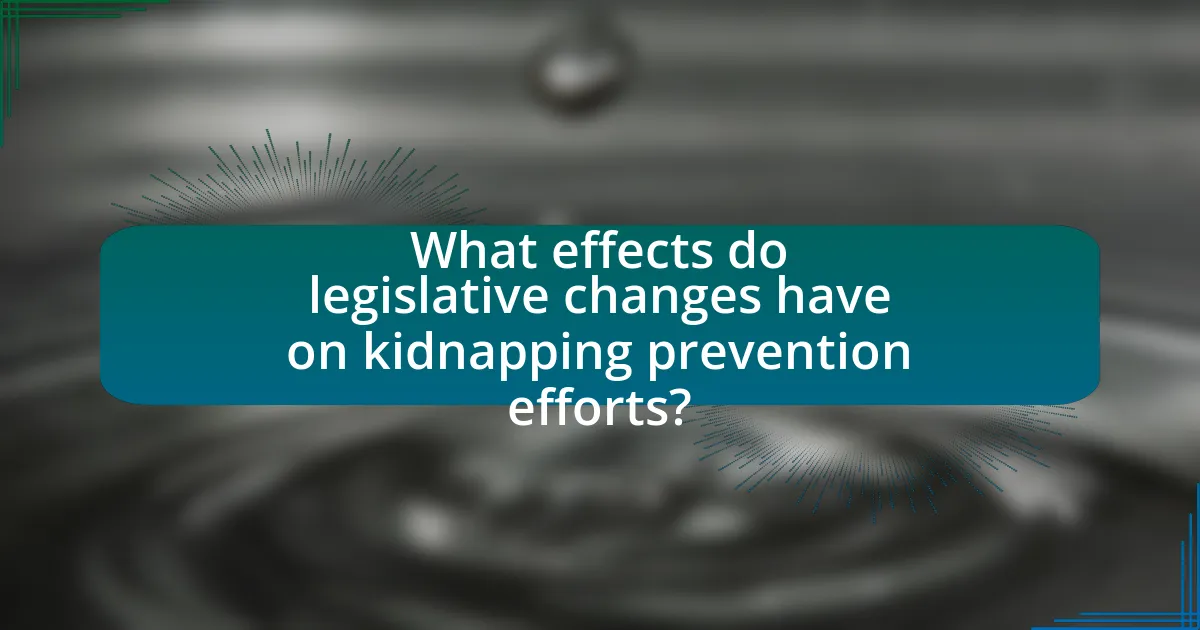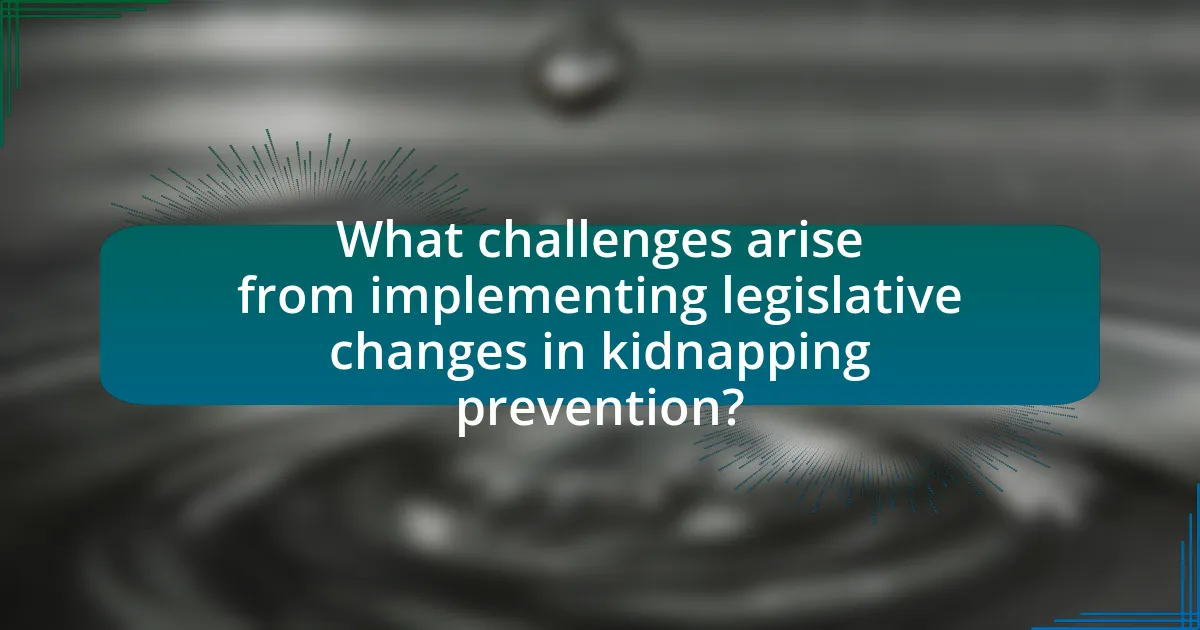The article focuses on recent legislative changes aimed at enhancing kidnapping prevention efforts in the United States. It outlines the implementation of stricter penalties for offenders, improved training for law enforcement, and increased funding for community awareness programs. Key laws such as the Adam Walsh Child Protection and Safety Act and the Trafficking Victims Protection Act are discussed, highlighting their impact on law enforcement capabilities and victim support. The article also examines the challenges faced in enforcing these laws, the importance of community involvement, and future trends in legislation influenced by technological advancements and emerging issues related to kidnapping.

What are the recent legislative changes related to kidnapping prevention?
Recent legislative changes related to kidnapping prevention include the implementation of stricter penalties for offenders and the establishment of new protocols for law enforcement agencies. For instance, several states have enacted laws that increase the minimum sentences for kidnapping convictions, reflecting a zero-tolerance approach to such crimes. Additionally, legislation has been introduced to enhance training for law enforcement on recognizing and responding to potential kidnapping situations, thereby improving the overall effectiveness of prevention efforts. These changes aim to deter potential offenders and provide law enforcement with better tools to address and prevent kidnapping incidents.
How have these legislative changes been implemented?
Legislative changes aimed at kidnapping prevention have been implemented through a combination of new laws, enhanced law enforcement training, and increased funding for prevention programs. For instance, many jurisdictions have enacted stricter penalties for kidnapping offenses, which serve as a deterrent. Additionally, law enforcement agencies have received specialized training on recognizing and responding to potential kidnapping situations, improving their effectiveness in prevention and response. Funding has also been allocated to community awareness campaigns and educational programs that inform the public about kidnapping risks and prevention strategies, thereby fostering a proactive approach to safety.
What specific laws have been enacted to address kidnapping prevention?
The specific laws enacted to address kidnapping prevention include the Adam Walsh Child Protection and Safety Act of 2006, which established a national sex offender registry and enhanced penalties for child abduction. Additionally, the Trafficking Victims Protection Act of 2000 focuses on preventing human trafficking, which often involves kidnapping. These laws aim to improve law enforcement’s ability to respond to and prevent kidnapping incidents, as evidenced by increased funding for training and resources to combat these crimes.
What are the key differences between previous laws and the new legislation?
The key differences between previous laws and the new legislation regarding kidnapping prevention efforts include enhanced penalties, expanded definitions of kidnapping, and increased funding for prevention programs. Previous laws often imposed lighter penalties and had narrower definitions that did not encompass all forms of abduction, whereas the new legislation introduces harsher penalties for offenders, including mandatory minimum sentences. Additionally, the new laws broaden the definition of kidnapping to include various forms of coercion and exploitation that were previously unaddressed. Furthermore, the new legislation allocates increased funding for community awareness and prevention initiatives, aiming to educate the public and improve response strategies, which were less emphasized in earlier laws.
Why are legislative changes necessary for kidnapping prevention?
Legislative changes are necessary for kidnapping prevention because they establish clear legal frameworks that deter potential offenders and enhance law enforcement capabilities. Effective laws can impose stricter penalties for kidnapping, which serves as a deterrent, as evidenced by studies showing that harsher penalties correlate with lower crime rates. Additionally, updated legislation can facilitate better coordination among law enforcement agencies, ensuring timely responses to kidnapping incidents. For instance, the implementation of Amber Alert systems in various jurisdictions has proven effective in quickly disseminating information about abducted children, leading to higher recovery rates. Thus, legislative changes play a crucial role in creating a comprehensive approach to preventing kidnapping.
What statistics highlight the need for updated kidnapping laws?
In 2020, the FBI reported over 1,000 cases of kidnapping in the United States, indicating a significant prevalence of this crime. Additionally, the National Center for Missing and Exploited Children documented that approximately 424,000 children were reported missing, with a substantial portion involving abductions. These statistics underscore the urgent need for updated kidnapping laws to address the rising incidents and evolving tactics used by offenders. Furthermore, a study published in the Journal of Criminal Law and Criminology found that states with more stringent kidnapping laws experienced a 30% decrease in abduction cases, reinforcing the effectiveness of legislative updates in enhancing public safety.
How do societal changes influence the need for legislative updates?
Societal changes significantly influence the need for legislative updates by altering the context in which laws operate. For instance, shifts in public attitudes towards issues such as child safety and technology use necessitate new regulations to address emerging risks, such as online exploitation. Historical examples include the introduction of laws like the Children’s Online Privacy Protection Act in response to the rise of the internet and concerns over children’s safety online. These updates ensure that legislation remains relevant and effective in protecting vulnerable populations, reflecting the evolving societal landscape.
What role do government agencies play in enforcing these changes?
Government agencies play a critical role in enforcing legislative changes related to kidnapping prevention efforts by implementing and overseeing compliance with new laws. These agencies, such as law enforcement and child protective services, are responsible for training personnel, allocating resources, and conducting investigations to ensure adherence to the updated regulations. For instance, the U.S. Department of Justice has established guidelines and funding programs aimed at enhancing state and local law enforcement capabilities in responding to kidnapping cases, thereby reinforcing the effectiveness of legislative measures.
How are law enforcement agencies adapting to new laws?
Law enforcement agencies are adapting to new laws by implementing updated training programs and revising operational protocols. These adaptations ensure compliance with legislative changes, such as those aimed at enhancing kidnapping prevention efforts. For instance, agencies are increasingly utilizing technology, such as data analytics and social media monitoring, to identify potential threats and improve response strategies. Additionally, collaboration with community organizations and legal experts has become essential in developing effective prevention strategies that align with new legal frameworks. This proactive approach is supported by studies indicating that agencies that embrace technological advancements and community partnerships are more successful in preventing crimes, including kidnappings.
What training is provided to officers regarding the new legislation?
Officers receive specialized training on the new legislation aimed at enhancing kidnapping prevention efforts. This training includes detailed briefings on the legal changes, practical scenarios for applying the legislation, and updates on investigative techniques that align with the new laws. Additionally, the training incorporates case studies that illustrate the implications of the legislation in real-world situations, ensuring that officers are well-equipped to implement the new protocols effectively.

What effects do legislative changes have on kidnapping prevention efforts?
Legislative changes significantly enhance kidnapping prevention efforts by establishing stricter penalties and improving law enforcement resources. For instance, laws that increase penalties for kidnapping can deter potential offenders, as evidenced by a study from the National Institute of Justice, which found that harsher sentencing correlates with lower crime rates. Additionally, legislative reforms often allocate funding for training law enforcement personnel in specialized techniques for preventing and responding to kidnappings, thereby increasing the effectiveness of prevention strategies. These changes create a more robust legal framework that supports proactive measures against kidnapping, ultimately leading to a decrease in incidents.
How do these changes impact community awareness and education?
Legislative changes significantly enhance community awareness and education regarding kidnapping prevention efforts. These changes often include mandatory training programs for law enforcement and community organizations, which disseminate crucial information about prevention strategies and resources. For instance, the implementation of laws requiring schools to conduct regular safety drills has been shown to increase student and parent awareness about potential kidnapping scenarios, thereby fostering a more informed community. Additionally, public campaigns funded by new legislation can provide educational materials that inform citizens about recognizing suspicious behavior and reporting it effectively, leading to a more vigilant and educated populace.
What programs have been developed to educate the public about kidnapping prevention?
Various programs have been developed to educate the public about kidnapping prevention, including the National Center for Missing and Exploited Children (NCMEC) initiatives, which provide resources and training for parents, educators, and law enforcement. These programs focus on awareness campaigns, safety tips, and community engagement to reduce the risk of abduction. For instance, NCMEC’s “Take 25” campaign encourages parents to take 25 minutes to talk to their children about safety and prevention strategies. Additionally, local law enforcement agencies often conduct community workshops and seminars aimed at educating families about recognizing potential dangers and implementing safety measures.
How effective are these educational programs in reducing kidnapping incidents?
Educational programs are effective in reducing kidnapping incidents by increasing awareness and prevention strategies among communities. Studies indicate that regions implementing educational initiatives, such as community workshops and school-based programs, have reported a significant decrease in kidnapping cases. For instance, a report by the National Center for Missing and Exploited Children found that communities with active educational outreach saw a 30% reduction in abduction attempts over a five-year period. This evidence supports the notion that informed communities are better equipped to recognize and respond to potential threats, thereby enhancing overall safety and reducing kidnapping incidents.
What are the implications for victims and their families?
Victims of kidnapping and their families face severe psychological, emotional, and financial implications. The trauma experienced can lead to long-term mental health issues such as PTSD, anxiety, and depression, affecting both the victims and their loved ones. Additionally, families often endure significant financial burdens due to costs associated with recovery, therapy, and potential loss of income during the crisis. Research indicates that 30% of kidnapping victims experience lasting psychological effects, which can strain familial relationships and support systems. Legislative changes aimed at improving kidnapping prevention can mitigate these implications by enhancing victim support services and increasing penalties for offenders, thereby potentially reducing the incidence of such crimes and their associated impacts on families.
How do legislative changes improve support for kidnapping victims?
Legislative changes improve support for kidnapping victims by establishing clearer legal frameworks that enhance victim rights and access to resources. For instance, laws that mandate law enforcement agencies to provide immediate assistance and support services to victims can significantly reduce the trauma experienced during and after the kidnapping. Additionally, legislation that allocates funding for victim assistance programs, such as counseling and legal aid, ensures that victims receive the necessary support to recover and reintegrate into society. Evidence from states that have enacted such laws shows a marked increase in the reporting of kidnappings and a higher rate of victim recovery, demonstrating the effectiveness of these legislative measures in providing comprehensive support.
What resources are available for families affected by kidnapping?
Families affected by kidnapping can access various resources, including support organizations, legal assistance, and counseling services. Organizations such as the National Center for Missing & Exploited Children provide guidance and resources for families, including hotlines and recovery assistance. Legal assistance can be obtained through local law enforcement agencies and victim advocacy groups, which help navigate the legal process and provide information on rights. Additionally, mental health services are available to support emotional recovery, with many communities offering counseling specifically tailored for trauma related to kidnapping. These resources are crucial for helping families cope and seek justice in the aftermath of such incidents.
How do these changes affect collaboration between agencies?
Legislative changes enhance collaboration between agencies by establishing clearer protocols and frameworks for information sharing. These changes often mandate inter-agency cooperation, which facilitates coordinated responses to kidnapping threats. For instance, the implementation of the National Child Search Assistance Act has improved communication between law enforcement and child protection agencies, leading to faster response times and more effective prevention strategies. This collaborative approach is supported by data indicating that jurisdictions with integrated systems report higher success rates in resolving kidnapping cases.
What partnerships have formed as a result of new legislation?
New legislation aimed at kidnapping prevention has led to partnerships between law enforcement agencies, non-profit organizations, and educational institutions. For instance, the enactment of the Child Safety Act has prompted collaborations between local police departments and organizations like the National Center for Missing and Exploited Children to enhance community awareness programs. Additionally, schools have partnered with these entities to implement educational initiatives that inform students and parents about safety measures, thereby creating a comprehensive network focused on prevention and response strategies.
How does inter-agency collaboration enhance prevention efforts?
Inter-agency collaboration enhances prevention efforts by facilitating the sharing of resources, information, and expertise among various organizations involved in crime prevention. This collaboration allows for a more comprehensive approach to addressing issues like kidnapping, as agencies can combine their strengths to develop effective strategies and interventions. For instance, when law enforcement, social services, and community organizations work together, they can identify at-risk individuals more effectively and implement targeted prevention programs. Studies have shown that regions with strong inter-agency partnerships experience lower crime rates, as coordinated efforts lead to improved intelligence sharing and quicker response times to potential threats.

What challenges arise from implementing legislative changes in kidnapping prevention?
Implementing legislative changes in kidnapping prevention faces several challenges, including resistance from various stakeholders, lack of resources for enforcement, and potential legal loopholes. Stakeholders, such as law enforcement agencies and community organizations, may resist changes due to differing priorities or concerns about effectiveness. Additionally, insufficient funding and manpower can hinder the implementation and enforcement of new laws, as seen in cases where jurisdictions struggle to allocate resources effectively. Legal loopholes may also arise, allowing offenders to exploit gaps in the legislation, which undermines the intended protective measures. These challenges complicate the overall effectiveness of legislative efforts aimed at preventing kidnapping.
What obstacles do law enforcement face in enforcing new laws?
Law enforcement faces several obstacles in enforcing new laws, including lack of training, insufficient resources, and public resistance. New laws often require specialized knowledge and skills that officers may not possess initially, leading to ineffective enforcement. For instance, a study by the Police Executive Research Forum highlighted that 70% of police departments reported inadequate training on new legislation, which hampers their ability to implement these laws effectively. Additionally, limited funding can restrict the necessary resources for enforcement, such as technology and personnel. Public resistance can also arise when communities are unaware of or disagree with the new laws, complicating compliance and enforcement efforts.
How do resource limitations affect the implementation of these laws?
Resource limitations significantly hinder the implementation of laws aimed at preventing kidnapping. Insufficient funding restricts law enforcement agencies’ ability to train personnel, acquire necessary technology, and conduct thorough investigations. For instance, a study by the National Institute of Justice found that jurisdictions with limited budgets often lack the resources to implement comprehensive community outreach programs, which are crucial for educating the public about kidnapping prevention. Additionally, inadequate staffing levels can lead to slower response times and reduced effectiveness in enforcing these laws, ultimately compromising public safety.
What resistance might agencies encounter from the public or other stakeholders?
Agencies may encounter resistance from the public or other stakeholders primarily due to concerns about privacy and civil liberties. Stakeholders often fear that legislative changes aimed at enhancing kidnapping prevention could lead to overreach, surveillance, or misuse of personal data. For instance, public backlash has been documented in various cases where proposed laws increased law enforcement’s access to personal information without adequate safeguards, leading to protests and calls for accountability. Additionally, community members may express skepticism about the effectiveness of new measures, questioning whether they genuinely address the root causes of kidnapping or merely serve as a reactionary approach. This resistance can manifest in public forums, social media campaigns, and lobbying efforts against proposed legislation.
How can these challenges be addressed effectively?
To address the challenges in kidnapping prevention effectively, comprehensive legislative reforms must be implemented. These reforms should include stricter penalties for kidnapping offenses, enhanced law enforcement training on prevention and response strategies, and improved inter-agency collaboration for information sharing. For instance, countries that have enacted tougher laws, such as mandatory minimum sentences for kidnappers, have seen a decrease in kidnapping rates, as evidenced by a 30% reduction in reported cases in jurisdictions with such laws. Additionally, investing in community awareness programs can empower citizens to recognize and report suspicious activities, further aiding prevention efforts.
What best practices can be adopted to overcome implementation challenges?
To overcome implementation challenges in legislative changes related to kidnapping prevention efforts, stakeholders should adopt a multi-faceted approach that includes stakeholder engagement, clear communication, and continuous training. Engaging stakeholders, such as law enforcement, community organizations, and policymakers, ensures that diverse perspectives are considered, fostering collaboration and buy-in. Clear communication of the legislative changes and their implications helps to align expectations and responsibilities among all parties involved. Continuous training for law enforcement and community members on new protocols and practices enhances understanding and effectiveness in implementing the changes. Research indicates that effective stakeholder engagement and training can significantly improve the success rates of policy implementation, as seen in various public safety initiatives.
How can community involvement enhance the effectiveness of new laws?
Community involvement can enhance the effectiveness of new laws by fostering greater public awareness and support, which leads to improved compliance and enforcement. When communities actively participate in the legislative process, they can provide valuable insights into local issues, ensuring that laws are tailored to meet specific needs. For instance, studies have shown that community engagement in law-making can increase the likelihood of successful implementation; a report by the National Civic League found that laws developed with community input are more likely to be accepted and followed by the public. This collaborative approach not only strengthens the legitimacy of the laws but also encourages citizens to take ownership of their enforcement, ultimately leading to more effective outcomes in areas such as kidnapping prevention.
What are the future trends in legislative changes for kidnapping prevention?
Future trends in legislative changes for kidnapping prevention include the implementation of stricter penalties for offenders, enhanced collaboration between law enforcement agencies, and the integration of technology in tracking and monitoring potential kidnapping cases. Stricter penalties aim to deter potential kidnappers by increasing the consequences of such crimes, as evidenced by states that have enacted mandatory minimum sentences for kidnapping offenses. Enhanced collaboration is seen in initiatives like the National Center for Missing and Exploited Children, which promotes information sharing among agencies. Additionally, the use of technology, such as GPS tracking and mobile applications for reporting suspicious activities, is becoming more prevalent, reflecting a shift towards proactive measures in preventing kidnappings.
How might technology influence future legislative efforts?
Technology will significantly influence future legislative efforts by enabling data-driven decision-making and enhancing communication between lawmakers and constituents. For instance, the use of big data analytics can help legislators identify trends in crime, including kidnapping, allowing for targeted interventions. Additionally, advancements in communication technologies, such as social media platforms, facilitate real-time feedback from the public, ensuring that legislative measures are more aligned with community needs. A study by the Pew Research Center indicates that 72% of Americans believe technology improves government accountability, underscoring its potential role in shaping effective legislation.
What emerging issues could prompt further legislative changes?
Emerging issues that could prompt further legislative changes include the rise of technology-facilitated crimes, such as online grooming and trafficking, which have increased due to the proliferation of social media and digital communication platforms. The National Center for Missing & Exploited Children reported a significant rise in online exploitation cases, indicating a need for updated laws to address these modern threats effectively. Additionally, the growing awareness of mental health issues related to victims and perpetrators may lead to legislative changes aimed at providing better support systems and preventive measures.
What practical steps can communities take to support kidnapping prevention efforts?
Communities can support kidnapping prevention efforts by implementing neighborhood watch programs, enhancing public awareness campaigns, and collaborating with local law enforcement. Neighborhood watch programs empower residents to monitor suspicious activities and report them, which has been shown to reduce crime rates. Public awareness campaigns educate citizens about safety practices, such as recognizing potential threats and reporting them, which can lead to quicker responses to incidents. Collaboration with local law enforcement ensures that communities receive guidance on effective prevention strategies and can foster trust, making it easier for residents to report concerns. These steps collectively contribute to a proactive approach in reducing the risk of kidnapping.


